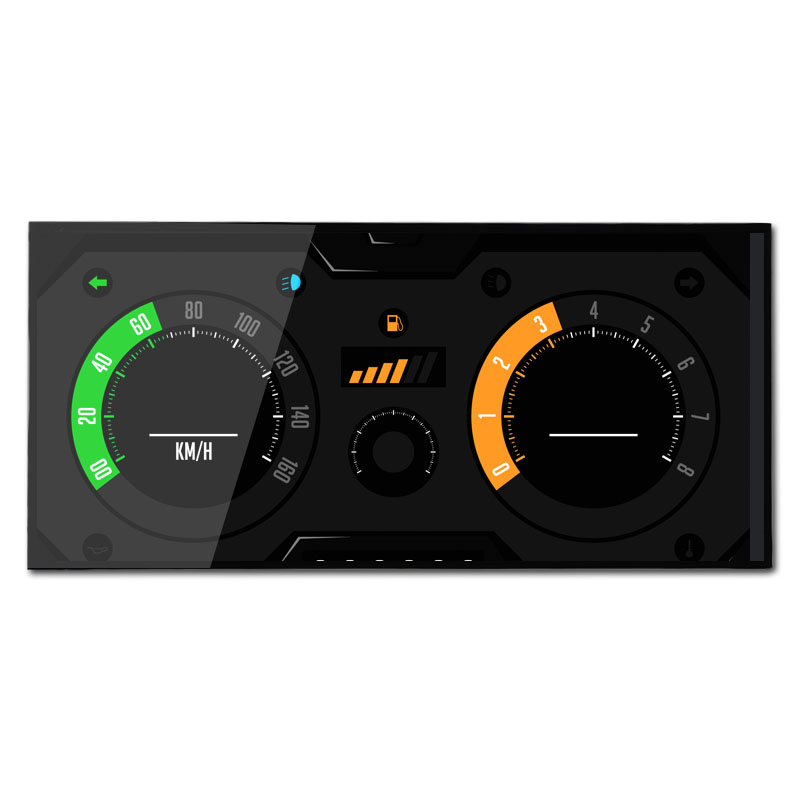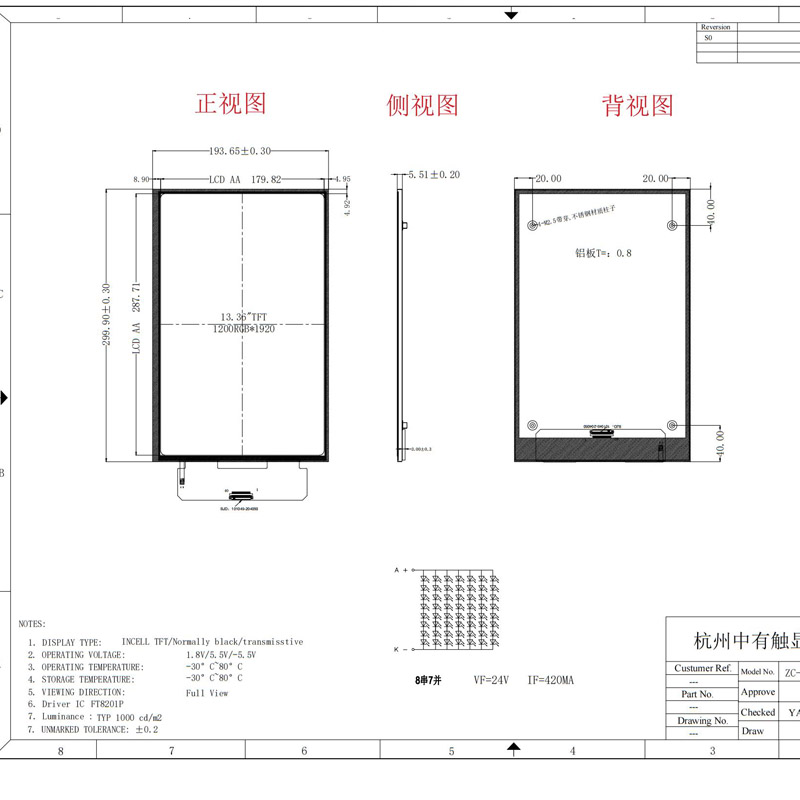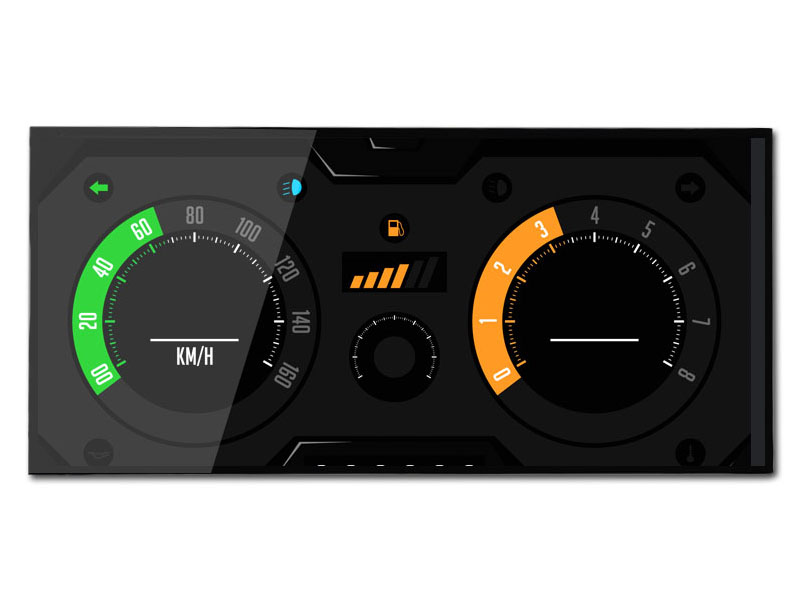In general perception, it is widely believed that the requirements for in-vehicle screens are extremely high, and this perception is indeed correct. The specific requirements also depend on different vehicle types and grades. In-vehicle screens can be roughly categorized into the following types: two-wheeled vehicles (electric bicycles, motorcycles), four-wheeled vehicles (passenger cars, trains), and trains (high-speed trains, subways, ordinary speed trains). This article will briefly elaborate on the requirements for screens in mid-to-high-end in-vehicle applications. Our company mainly serves mid-to-high-end customers in the in-vehicle field, so we have some experience to share regarding LCD screens in this field.

1)Two-wheeled vehicle LCD screens (electric bicycles, motorcycles, etc.)
First, let’s talk about two-wheeled vehicles. The working environment characteristics of such vehicles are as follows:
Fully exposed to the outdoors: Subject to sun exposure and rain (high temperatures, heavy rains, humidity fluctuations) and strong ultraviolet radiation;
Intense vibration: Severe road bumps during driving (especially on unpaved roads) with large body shaking amplitude;
Complex lighting conditions: Direct strong sunlight during the day (prone to reflection) and weak light at night (need to prevent glare);
Operation scenarios: Mostly used as instrument panels (displaying speed, battery level, mileage, etc.), may require operation with gloves, or face splashes of dust and mud.
Core requirements for the display screen:
Extreme environment resistance:
Wide temperature range: Must support -30℃~80℃ (to cope with low temperatures in winter and high temperatures after sun exposure in summer), avoiding black screens at low temperatures and brightness attenuation at high temperatures;
High protection rating: The entire screen must have at least IP54 (dustproof + splashproof) rating; in some scenarios, IP65 (fully waterproof against water jets, to cope with heavy rains or car washing) is required to prevent rainwater and dust from entering internal circuits.
Vibration resistance and durability:
Compliance with vibration resistance standards (e.g., IEC 60068-2-6): The screen module (especially the backlight and touch layer) must have a reinforced design to avoid loose cables, display afterimages, or touch failure caused by long-term vibration;
UV resistance and anti-aging: The screen surface must have a UV-resistant coating to prevent the casing from yellowing and the display panel from aging and cracking due to long-term sun exposure.
Visibility and operational convenience:
High brightness + anti-glare: Brightness ≥ 600nits; the cover glass surface must undergo AG matte treatment or polarizing technology to reduce reflection;
Simple touch/buttons: If touch is supported, it must be wear-resistant (resistant to scratches from nails and gloves), or physical buttons (more durable) should be used to avoid misoperation.
Low power consumption:
Two-wheeled vehicles have limited battery capacity, so the display screen must adopt a low-power design to avoid excessive consumption of battery life.
Recommended products:
Sunlight Readable LCD Display 7 inch with Wide Temperature
1.9 inch High Bright LCD Display with Cover Glass
2)Electric four-wheeled vehicles (passenger cars, electric trucks, low-speed electric vehicles, etc.)
Working environment characteristics:
Semi-enclosed space:
The interior has air conditioning to regulate temperature (but the short-term high temperature inside the car can reach over 60℃ after sun exposure in summer, and the low temperature is around -10℃ in winter);
Moderate vibration:
Vibration during driving is gentler than that of two-wheeled vehicles (depending on the suspension system), but still needs to cope with road bumps;
Composite functions:
Displays include instrument panels (vehicle status), central control screens (navigation, entertainment, vehicle control), rear-seat entertainment screens, etc., which need to support complex interactions;
Electromagnetic environment:
Dense electronic devices in the car (motors, battery management systems, radars, etc.) are prone to electromagnetic interference.
Core requirements for the display screen:
Environmental adaptability:
Wide temperature range: Supports -30℃~80℃ (to cope with temperature differences inside the car in extreme weather), ensuring normal startup at low temperatures and no lag at high temperatures;
Anti-fog and anti-condensation: When the humidity inside the car changes (e.g., opening windows on rainy days), the screen surface must be anti-fog treated to avoid condensation affecting display.
Display and interaction performance:
High resolution and color: Central control screens must have ≥ 1080P resolution and 100% sRGB color gamut (to ensure accurate colors of navigation maps and videos);
Touch experience: Supports multi-touch (e.g., two-finger zooming of maps), operation with gloves (in winter), and anti-misoperation (to avoid accidental touches during driving), with a response speed ≤ 100ms;
Anti-glare and brightness adaptation: Screen brightness automatically adjusts with external light (≥ 500nits in strong light, ≤ 50nits in weak light), paired with anti-glare glass to reduce reflection.
Stability and anti-interference:
Vibration and impact resistance: Passes automotive-grade vibration tests (e.g., ISO 16750-3) to avoid loose connections between the screen and the car body or display glitches caused by long-term vibration;
Electromagnetic compatibility (EMC): Complies with automotive-grade EMC standards (e.g., CISPR 25) to prevent signal abnormalities caused by interference from in-vehicle motors, radars, and other devices.
Long lifespan and reliability:
Service life ≥ 5 years (matching the vehicle lifecycle), with backlight attenuation rate ≤ 20% (within 5000 hours) to avoid early brightness deficiency.
Recommended products:
Vehicle LCD Display 10.25 inch with Wide temperature High Brightness
12.3 inch LCD Panel for Automotive 720×1920, Brightness 1000 nits
13.4 inch Display Panel for Vehicle 1200×1920, Brightness 1000 nits

3)Trains (high-speed trains, subways, ordinary speed trains, etc.)
Working environment characteristics:
Enclosed space: Indoor temperature (18-26℃) and humidity (40%-60%) are stable (regulated by air conditioning systems) with no drastic temperature differences;
Gentle vibration: Vibration during driving is mainly smooth (due to high track smoothness) with small impact;
Long operation time: Operates 10-16 hours a day, requiring continuous and stable work with short maintenance downtime;
Functional scenarios: Include driver’s console displays (showing speed, signals, fault codes), carriage information screens (stations, arrival times), and passenger entertainment screens (videos, news).
Core requirements for the display screen:
Long-term operation stability:
Mean Time Between Failures (MTBF) ≥ 50,000 hours (approximately 5.7 years) to avoid frequent black screens or lags (which affect driving safety or passenger experience);
Heat dissipation design: Long-term high-load operation (e.g., video playback on entertainment screens) requires low power consumption + efficient heat dissipation to prevent performance degradation due to overheating.
Display and adaptability:
High-reliability display: Driver’s console screens need high contrast (≥ 1000:1) to ensure clear visibility of data under strong light (e.g., at tunnel entrances/exits); passenger information screens need wide viewing angles to ensure visibility for passengers in different seats;
Compatibility: Supports in-vehicle system interfaces (e.g., LVDS, HDMI) and links with train control modules and broadcasting systems to achieve real-time information synchronization (e.g., arrival reminders).
Anti-interference and safety:
Strong anti-electromagnetic interference: Train high-voltage power supply systems and communication equipment generate a strong electromagnetic environment, requiring compliance with EN 50155 railway electronic equipment standards to ensure accurate display data (especially for driver’s screens);
Maintenance convenience:
Modular design: Facilitates quick replacement of faulty components (e.g., backlight panels, touch modules) to reduce maintenance downtime;
Scratch and wear resistance: Surfaces of screens touched by passengers must be hardened to resist daily scratches.
Recommended bar displays:
QV240FBM-N10 BOE LCD Panel 24 inch 1920*360 pixels Brightness 300 cd/m²
